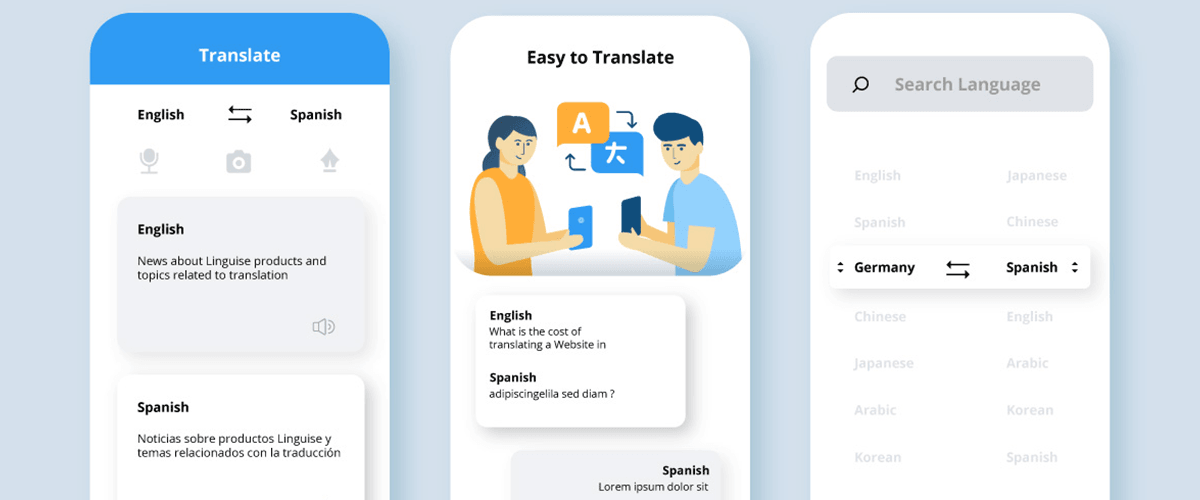Neural machine translation (NMT) is an algorithm used to translate words from one language to another. It is said that high quality NMT can determine the context of the translation and use models to offer a more accurate translation. Google Translate, DeepL, Yandex, Baidu Translate are well-known examples of NMT available to the public via browser automatic translation.
Let’s get deeper into it.
What is a “neural network” for translations?
Neural Networks are called this way because the system is vaguely inspired by the biological neural networks that constitute the human brain. Elements that represent the neurons are organized into layers (neural network).
- The network is constituted by units called “nodes” (like human neurons) and all the units are connected
- Each connection is a number that is called an “edge”
- Neurons and edge connection is represented by a specific number called a “weight”
During the processing the weight is adjusted, for example once the machine has more translated data to analyze.
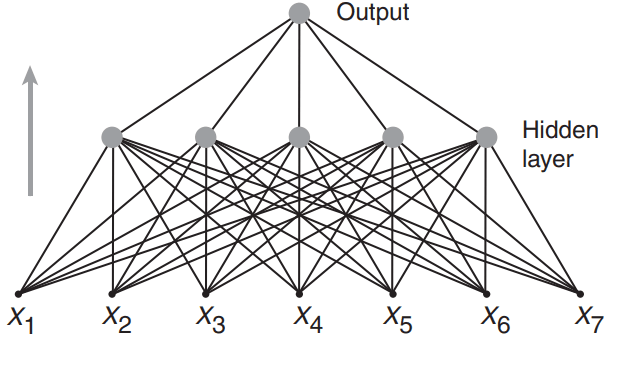
Applied to translation, unlike the traditional phrase-based translation system, which consists of many small subcomponents that are tuned separately, neural machine translation attempts to build and train a large neural network that reads a sentence and the context.
How does the translation model work?
The simple answer is via a complex mathematical formula (represented as a neural network). This formula takes in a string of numbers as inputs and outputs a resulting string of numbers. The parameters of this neural network are created and refined via training the network with millions of sentence pairs (e.g. English and Chinese sentence pair translations).
Neural Machine Translation is using models
A machine can also be trained to meet the specific needs of a sector (legal translation, medical translation, etc.) or a customer’s area of activity, which will have its vocabulary.
NMT are primarily dependent on the training data used to train the neural network, as it learns to mimic the data it has been trained with. Many high-accuracy industry specific and custom developed machine translation (MT) models still incorporate both neural and statistical methods today to squeeze the best performance for our clients
Each sentence pair modifies the neural network model slightly as it runs through each sentence pair using an algorithm called back-propagation.
Translation model illustration
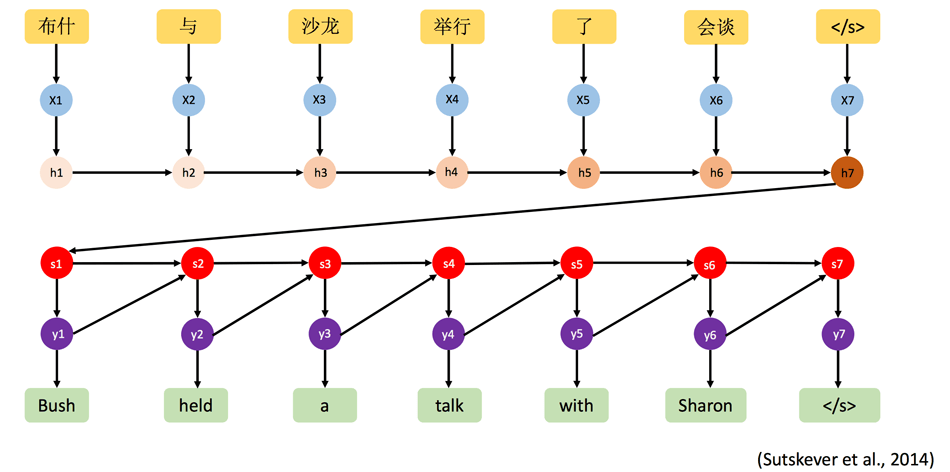
Neural Machine Translation can learn how to translate better
As opposed to some old engines still on the market (statistical and rule-based), a neural engine models the entire process of machine translation through a unique artificial neural network. Google starts using its own GMNT back in 2016.
Today, the machine – like the human brain – is capable of producing a reliable translation as well as learning a language, and is therefore constantly improving the quality of the translated material. To improve the performance of the machine, it is “trained” by human translators.
Google neural machine translation illustration
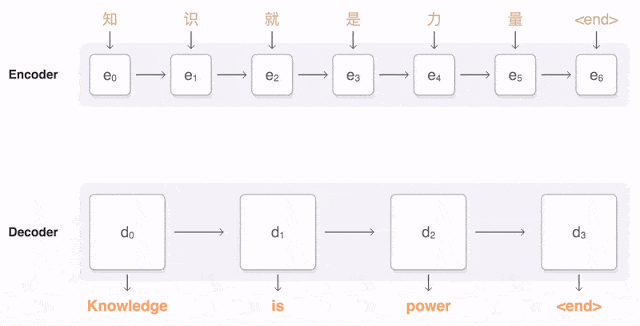
In practical terms, the NMT quality depends on
- A huge volume of translated data (words, segments of sentences, and texts already translated)
- The quality of the translation provided to improve the reliability and sophistication of the results
- The power of the computers used to create the models and also in some case to handle real-time translations
The most popular generic neural machine translation engines
Machine translation becomes better and better every year, but depend on training data and the algorithm quality. Depending on your needs, the machine translation engines can be generic or custom (with custom translation models). There’s no doubt that generic machine translation engines will reach the same quality as custom machine translation engines in the future, but that’s not yet the case.
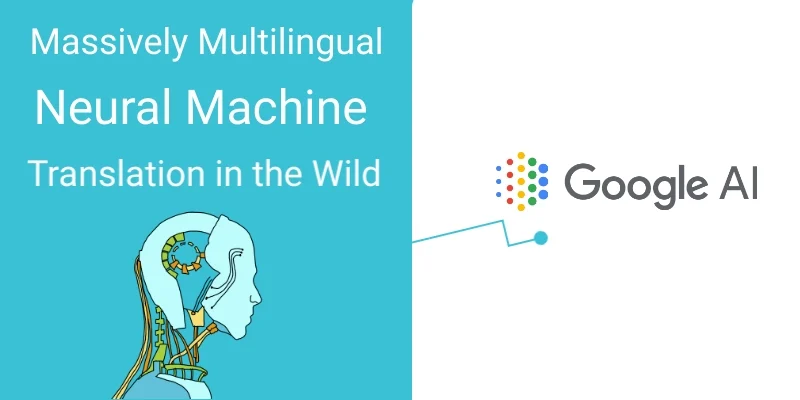
Let see who are the popular generic neural machine translation engines
Google Translate
Generally considered one of the leading machine translation engine, they almost invented it 🙂
No doubt that, based on our latest tests, the quality is better than competitor and the number of languages is above competitors too.
DeepL
DeepL is a smaller company from Germany, originally based on the data of Linguee website. Quality is really close to the Google API, but they have fewer languages available.
DeepL has redefined the standard for machine translation. So far, we’ve been accustomed to machine translations that often sound mechanical and artificial because they rely on recurrent neural networks and word vectors. As a result, most people only use services like Google Translate occasionally, typically when traveling. However, DeepL represents a groundbreaking shift. Its neural network-based algorithms can translate content in a way that closely resembles the work of a professional human translator.
DeepL subscription price depends on the language you choose. Prices start from $ 8.74 / month.
Microsoft Translator
This is the translation tool you probably use in Office Word. This is another cloud-based neural engine, called Microsoft Translator.
Microsoft Translator supports over 70 languages, although not all features are available for all of them. With features like document translation and chat translation, Microsoft’s translation tool offers a more global approach. Pricing is set at $10 per billion characters, which is half the cost compared to Google Translate. The combination of quality and language versatility sets it apart.
If you’re looking for an average quality but with small fees, this is the way to go.
Amazon Translate
Amazon Translate is also neural-based and is closely integrated with Amazon Web Services (AWS). The quality is poor compared to the 2 above, except in certain Asian languages.
Amazon Translate employs advanced neural machine translation technology, ensuring swift translations with remarkable accuracy, all at a competitive cost. Unlike traditional statistical and rule-based translation methods, neural machine translation harnesses the power of deep learning models, resulting in more precise translations that sound increasingly human.
With Amazon Translate, you can effortlessly translate large volumes of text for analytical purposes, localize content such as websites and applications for your diverse user base, and seamlessly enable cross-lingual communication among users.
Amazon Translate prices start at $15 / million characters.
SYSTRAN Translate Pro
SYSTRAN Translate Pro, a professional cloud-based translation program, offers versatile translation capabilities. It can translate text, documents (including Word, PDF, and PowerPoint), and web pages into over 55 languages and an impressive 140 language combinations. SYSTRAN also provides specialized translation models tailored to various industries, ensuring precise translations for specific business needs.
Basic translations typically require minimal to no editing, especially in technical fields where years of research and development have fine-tuned accuracy. The program efficiently handles the translation of entire documents in popular formats, automatically detecting the original document’s language.
Moreover, SYSTRAN can translate text from websites and even images into numerous languages, meticulously cataloged in its extensive database. By utilizing custom dictionaries, you can further enhance and personalize translations to suit your specific context. This is start from $5,41 / month.
ModernMT machine translation
MMT represents a personalized machine translation solution that operates intelligently by drawing insights from post-editing and translation memories throughout the translation process. Its unique design allows it to adapt to the content in real-time, offering contextually relevant machine translation suggestions as the translator works.
What sets MMT apart is its absence of a need for initial setup or training. Instead, it rapidly and effortlessly absorbs new information from translation memories and corrections. This feature ensures swift and precise translation processes as MMT continuously learns and adapts to the input material.
These technologies find application in fully automatic translation production contexts and serve as a backend solution for interactive post-editing scenarios.
ModernMT start from $8 / milion characters.
Reverso Translation
Reverso is a free AI translation tool that supports translations in 18 languages. Users can input text or speak words within Reverso to receive their desired translations.
Beyond translation, Reverso is a valuable resource for language learners aiming to improve their skills and expand their vocabulary. Translations come with relevant examples and explanations, creating an environment for users to enhance their writing, speaking, and reading abilities.
Key features of Reverso include document translation, in-context examples, pronunciation guidance, flashcards, search history review, and the ability to compile vocabulary lists.
Crowdin
Crowdin is a translation and localization management platform designed to aid both individuals and businesses in translating a wide array of content into various languages. The platform offers a diverse range of tools and viewing options aimed at streamlining the translation process.
Crowdin is not limited to niche machine translation; it encompasses a comprehensive set of features, including task management, payment processing, and collaborative functions that are accessible to all team members. As a result, Crowdin facilitates more accurate project delivery predictions and improves communication within the team.
Crowdin pricing starts at $50.
Neural translation quality by language
The neural machine translation has increased its quality a lot since 2016. For example, in a major language pair like the first one in the table below, from 80% to 97% in 2022! And no doubt that in a couple of years it’ll be hard to spot a difference between a human translator and a machine translation in this language pair.
| NMT Translation | Human Translation | Quality | |
| English-Spanish | 5,428 | 5,550 | 97% |
| English-French | 5,295 | 5,496 | 96% |
| English-Chinese | 4,594 | 4,987 | 92% |
| Spanish-English | 5,187 | 5,372 | 96% |
| French-English | 5,343 | 5,404 | 98% |
| Chinese-English | 4,263 | 4,636 | 92% |
Some use cases for Neural Machine Translation
Ecommerce and business online websites
Translation opens a new market, this is simple as that. If you know your audience or analyze your audience with a statistic tool you’ll easily find a new potential country to target. Usually, it’s country that does not understand your language at all or countries with high demand for your product.
For example, in Spain the English language level is lower than in Norway, so an English translation might bring more conversion. Check this post is you want to know more about audience analysis.
Short timeframe to translate large amounts of web content

The neural machine translation models require a large amount of high-quality translated data to improve its neural networks, so it can rapidly produce precise translations.
A good example of the need to translate large amounts of content is to translate instructions to use a complex product like an industrial machine. This is typically a PDF of 1 thousand pages. With a neural machine translation, it could be done in a minute in multiple language.
Customer support ticket
The direct customer support is often the first contact with customer, so it’s crucial to give accurate information to resolve issues as fast as possible. Allowing content to be translated in his native language is a remarkable experience in that regard instead of the “we do support in English only” 🙂
Neural Machine Translation for repetitive content
NMT is especially effective at translations that is very repetitive, such as translation for similar products.
For example, if you’re selling 50 different headsets models online, using human translator only will require to do 50x very similar translation for similar characteristic of each product.
Benefits from Neural Automatic Translation for your website
Integrating neural automatic translation into your website can bring several benefits. Here are some of the main advantages:
- Global accessibility: By offering automatic translations on your website, make your content accessible to a global audience. Visitors from different regions and language backgrounds can easily understand and engage with your website, thereby increasing user satisfaction and engagement.
- Enhanced user experience: Automatic translation provides a good user experience. Visitors can browse your website in their preferred language, resulting in a more convenient and personalized experience.
- Increased reach and traffic: You can expand your reach and attract visitors from different language communities. This can lead to increased traffic to your website, potentially driving more conversions and sales.
- Enhanced SEO: When you provide translated content on your website, search engines can index and rank it for relevant language-specific search queries. This increases your website’s visibility on search engine results pages (SERPs) in multiple languages, increases your overall organic traffic, and enhances your search engine optimization (SEO) efforts.
- Localization for target markets: Neural automatic translation allows you to localize your website content. This localization can involve tailoring product descriptions, marketing materials, and user interfaces to resonate with local audiences, leading to increased customer engagement and conversions in those markets.
- Cost and time efficiency: With an automated translation system, you can quickly and automatically translate new content or updates on your website without the need for a human translator, reducing costs and streamlining your localization process.
Linguise, Neural Machine Translation service for your website
Linguise is an automatic translation service with neural network model technology or NMT that is able to quickly convert text from one language to another. At Linguise, we use the best Google NMT so that we can produce the most accurate translation for your website.
Not only that, Linguise provides a cache server for your translations. So that once a translation is created or needs to be updated we check if we can serve an instant cached version. This reduces loading times by up to 80%. Cached pages are HTML only and retain all the dynamic features of the original language version.
To improve the translation results, Linguise also offers a variety of other interesting features, such as.
- Front-end live editor.
- Translation exclusion (text to ignore, URL exclusion, content exclusion, ignore inline, and text replace).
- Multilingual SEO, and many other features.
Apart from that, you will get many of the benefits offered by Linguise in the free and paid version packages. What benefits will you get? Here are some of them.
- Supports more than 80 languages: The Linguise plugin provides more than 80 languages that you can add to your WordPress site for translation options.
- Unlimited language selection: Linguise offers many languages, and every package offered by Linguise always offers unlimited language usage. So you are free to add whatever languages you want regardless of the number.
- Free custom installation: Linguise can help you install plugins for free. Simply register with Linguise and then contact our team for a free installation request.
- High accuracy: Linguise has a high level of translation accuracy, especially in popular languages. Translation rates range from 82% – 98%.
- 100% support SEO: Linguise will continue to optimize SEO, so that the results of translated content will appear in search engines according to the intended language. Not only that, URLs and meta descriptions are also translated automatically. So that 1 content can be a lot of content with different languages.
That’s an explanation about Linguise, an automatic translation service with a neural network translation model so that it can produce translations with the best results.
Up to this point, are you interested in using Linguise as a touchable website with neural network technology? If so, see the explanation below.
Translate a website with Neural Machine Translation Linguise
To be able to use this service, you need to follow the steps below starting from registration to setting up the Linguise plugin on the website dashboard.
Step 1: Registration & get the API key
To get started, the first step is to sign up for a Linguise account and acquire an API key. After the registration process is complete, you will get access to the Linguise dashboard. To find the API key, simply go to the Settings menu and look for the API key option. Next, copy the API key to your clipboard.

Step 2: Select the destination language
The next step is to add your preferred language to the list of translation options. On the 1-month free trial version, you have the freedom to add as many languages as you want.

Step 3: Install & configure the plugin
After that, go to your website dashboard and install the Linguise plugin. Next, select the Add plugin menu and search for Linguise. Install and activate the plugin. After successfully activating the plugin, go to the Linguise plugin settings.
In the Linguise plugin settings, you will find fields like the following. There, you can paste the API key you obtained earlier.

Then, you will find a menu to set the flag as the logo for each language. You can place it either at the top, bottom or any other position on your site’s appearance.
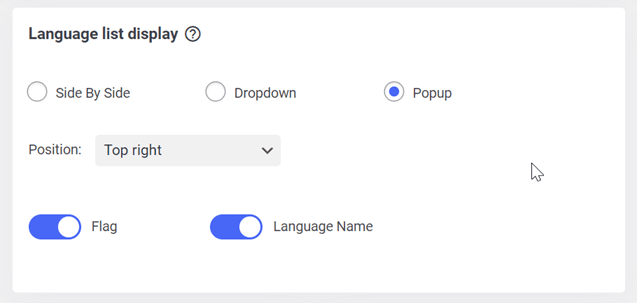
If the position of the language switcher has been set, save the changes then reopen your website, the result will be like this.
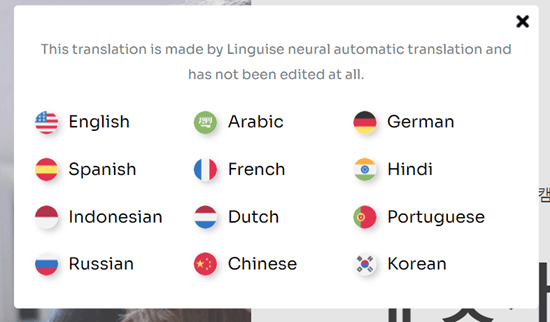
Conclusion
So far, you already know better what is Neural Machine Translation. Neural Machine Translation or NMT is an algorithm to translate words from one language to another.
It is called a neural network because it is inspired by the biological neural network that forms the human brain. Elements representing neurons are arranged into layers (neural network).
The NMT model is widely used in various translation services, one of which is Linguise. Linguise is an automatic translation service that uses a neural network model for translation into other languages. With this model, Linguise is able to produce high-accuracy translation results of until 98%.
Come on, use Linguise as your website translation service for a better multilingual website!

